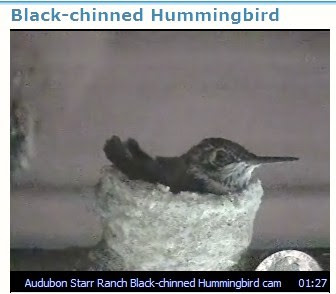
This is Primus on nest right.

And if you look carefully, you'll see a bit of Secundus peeking out from behind a limb on the left.
Now see if you can figure out what is going on.












Updates from Sally of Kentucky--
And then there was one- Starr Ranch hummer gone this morning.
And then there was one- Starr Ranch hummer gone this morning.
And Portland's Hawk jungle gym as the eyasses both branch to various places on the fire escape.
Sally
Robin of Illinois Updates the Phillie Franklin Institute Red-tail Nest
http://www.phillycom/inquirer/health_science/daily/20090604_Franklin_Institute_s_baby_hawks_lern_to_fly.htmlTwo of the three red-tailed hawk chicks on a ledge of the Franklin Institute- webcam stars that have attracted thousands of viewers since they hatched on April 16 - took their first flights yesterday, observers said. The news spread quickly through followers who have been posting comments on the Ustream.TV Web site, which shows the Franklin's cam feed. Online viewers spiked from an average of about 300 at any given time to 800 by midafternoon Overall, the site has attracted 359,011 unique visitors since it went live in early March, Ustream president Brad Hunstable said.The drama started shortly before 9 a.m. When Della Micah, a Plymouth Meeting woman who was checking the cam feed on her laptop from a sidewalk below, tweeted on the site: "I think one may have flown! Just realized only one on the nest & one on the ledge. Wow!"But the next time she looked back at the ledge, it was there. She never saw it fly. Janet Wieczerzynski, a Northeast Philadelphia woman who saw the post, grabbed her binoculars, and leaped into her car with her son, Matt. About 11:30 a.m., she saw one flap more vigorously than usual. And "all of a sudden, it just went," she said.The bird flew over their heads, across the Vine Street Expressway, then into trees. An adult flew right behind it. A second hawk flew off midafternoon."We're losing our babies," said Troy Collins, a senior vice president. "To watch three eggs, then three birds survive everything nature has to throw at them, and to see them preparing to leave the nest is truly remarkable."But they're not yet independent. Typically, once they fly - or fledge - thebirds stay very close to the nest for a few days, then nearby for about 2 1/2weeks until they are good at sustained flight, said Doug Wechsler, an ornithologist with the Academy of Natural Sciences. They start learning to hunt after about four weeks, and the parents will keep feeding them for another four weeks after that, he said.Indeed, it might be easier to hear the youngsters than see them."When the chicks are hungry, they start screaming, telling Mom and Pop, 'I'm hungry,' " said ornithologist Leonard J. Soucy Jr., founder of the RaptorTrust, a bird rehab center in Millington, N.J.He's not surprised at all the hoopla. He recalled New York's Pale Male, ahawk that 17 years ago generated worldwide attention when he took up residence on the ledge of an apartment building near Central Park. (He and his latest mate, Lola, are still there.)"It's a phenomenal thing to see something that is the epitome of a wild creature sitting outside your [urban] balcony," Soucy said.People became almost addicted, he said. "I call them hawkaholics."Glenolden's Kay Meng, who has photographed the hawks extensively, thinks people are drawn to "something that's bigger than ourselves.""For me, it's an affirmation that life is good and that there are miracles every minute of every day if you are open to them."
I actually have a wee bone to pick with Dr. Wechsler. He says that the fledglings start learning to hunt at about 4 weeks off the nest. I suppose it depends on one's definition of "learning to hunt" so perhaps not a bone after all but in NYC for instance, his young one day off the nest, Pale Male Jr., would attract the youngster's attention by circling above them until they looked up and stared. Then he would demonstrate hunting techniques for nabbing pigeons out of the sky. He even broke it down into individual steps. First the demonstration of the mid air turn. Why the last step first I'm not sure, except it was rather the most difficult move involved. Then the flushing of pigeons off the roof, the chasing of the circling pigeons with less and less speed until they were almost on him from the rear, and then the mid-air about-face. Nab.
All,
The Briarwood Queens eyass has safely fledged on June 3rd between 2pm and 6:30pm. I wanted to confirm the fledge before posting this update. This morning I was able to confirm with a rooftop visit to the nest that the nest is empty. It took about 30 minutes to find the parents this morning and a couple more hours to find the fledgling. It's doing fine on some six story apartment building rooftops to the East of its nest. It's flight appears to be strong and its landing skills very coordinated for the first full day out of the nest. Thankfully, the significant amount of razor wire and the busy Expressway in the immediate fly-out path of the nest didn't become a problem.
Best, Jeff
The Briarwood Queens eyass has safely fledged on June 3rd between 2pm and 6:30pm. I wanted to confirm the fledge before posting this update. This morning I was able to confirm with a rooftop visit to the nest that the nest is empty. It took about 30 minutes to find the parents this morning and a couple more hours to find the fledgling. It's doing fine on some six story apartment building rooftops to the East of its nest. It's flight appears to be strong and its landing skills very coordinated for the first full day out of the nest. Thankfully, the significant amount of razor wire and the busy Expressway in the immediate fly-out path of the nest didn't become a problem.
Best, Jeff
Donegal Browne















































